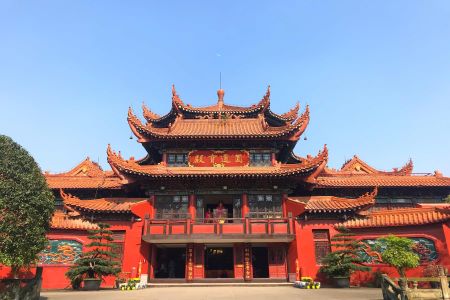Chinese Name: 昭觉寺 Pronunciation: Zhāojué Sì
Building Time: 627-649
Best Visiting Season: All seasons
Opening Hours: 8:00 - 17:00
Admission Ticket Fare: Free
Recommended Time for Visit: 1-2 Hours
Occupied Area: About 85.3 thousand square meters
Address: No. 333 Zhaoqing Road, Chenghua District, Chengdu City, Sichuan Province, China
Building Function: To conduct religious activities, such as burning incense, worshiping Buddha and so on

Located in the north of Chengdu and next to Chengdu Zoo, Zhaojue Temple was the place where emperors of the Tang and Song Dynasties conducted religious activities. With the magnificent layout and lush forest, it is considered to be one of the most famous ancient temples in Chengdu. In 1983, Zhaojue Temple was designated by the State Council as a national key Buddhist temple in Han Nationality areas.
Over the years, the management of Zhaojue Temple has also achieved gratifying results. The temple has not only restored the traditional temple system, but also established the Zhaojue Temple Management Committee, a temple management organization, and formulated various regulations and systems for religious activities, cultural relics protection, financial income and expenditure, safety and health, and institutionalized and democratic temple management.
The monks take the temple as their home, work hard, manage carefully, and serve visitors warmly. Everything in the temple is in order. The monks reclaimed about 8,666 square meters of wasteland, cultivated more than 1,000 saplings, planted more than 2,000 trees, fully greening the whole temple. They raised funds to set up tea gardens, vegetarian restaurants, canteens and other service businesses, serving the society and the masses warmly and thoughtfully.
In addition, the temple has been well received by Chinese and foreign tourists. Zhaojue Temple has done well in social welfare undertakings and has made donations for national construction, bridge and road repair, and social welfare many times.

In the Han Dynasty, Zhaojue Temple was the former residence of an official in Sichuan. In the Tang Dynasty, it was built into a monastery and named Jianyuan Monastery. In 877, it was renamed Zhaojue Temple. In the Northern Song Dynasty, it took more than 30 years to complete the restoration of Zhaojue Temple. Over 300 halls and rooms were added to the temple and the main buildings such as the Great Buddha Hall, Chanting Hall, Arhat Hall, Six Ancestors Hall, Charity Hall, and Mercy Hall were built.
After the founding of the People’s Republic of China, Zhaojue Temple received the care and attention of the party and the government. Abbot Ciqing served as the chairman of the Buddhist Association of Chengdu City, and was elected as a deputy of the National People’s Congress (NPC). In 1984, with the help and support of the government, Mountain Gate, Bajiao Pavilion, Hall of the Heavenly Kings, and other pavilions were repaired.
Zhaojue Temple is always associated with famous people in modern China. In March 1917, Zhu De (1886-1976), one of the founding fathers of China, was attacked by a warlord and his soldiers in Sichuan. Zhu De and other soldiers took shelter here. Because of its location and quiet environment, the temple protected them from being found. Zhu De had a deep friendship with Abbot Liaochen. He lived in the Baxian Hall. After leaving the temple, he asked his secretary to send a plaque to Zhaojue Temple. After the founding of the People’s Republic of China, he also sent orchids and other objects to the temple many times.
Zhang Daqian (1899-1983), a famous modern painter, calligrapher, and poet, once lived in Zhaojue Temple for four years. He devoted himself to the study of painting art and left some precious calligraphy works in the temple. Now visitors still can appreciate his precious works that are relevant to Zhaojue Temple.
The vegetarian food at Zhaojue Temple is worth tasting.
Visitors will also be amazed by the one-thousand-year-old tree outside the Great Buddha Hall of the temple, with a stone tablet inside the trunk. The tree is considered to be one of the Tree Kings in Sichuan Province.
Take bus 1, 49, 53, 71, 83, 85, 87, or 530 and get off at Zhaojue Temple Bus Terminal.
Take Metro Line 3 and get off at Zhaojue Temple South Road Station (Exit A). Walk northward along Zhaojue Temple South Road and turn right to Ren’ai Road. Walk along Ren’ai Road for about 360 meters to Zhaohui Road and then turn to Zhaoqing Road. Go north along Zhaoqing Road to the south gate of Zhaojue Temple.
Chinese: 请带我去昭觉寺。English: Please take me to Zhaojue Temple.
If you go to Zhaojue Temple from the center of Chengdu City (Ritz-Carlton), it takes about 25 minutes (about 25 yuan).
If you go to Zhaojue Temple from Chengdu Station, it takes about 15 minutes (about 20 yuan).
If you go to Zhaojue Temple from Chengdu East Station, it takes about 20 minutes (about 20 yuan).
If you go to Zhaojue Temple from Chengdu Shuangliu International Airport, it takes about 45 minutes (about 80 yuan).
